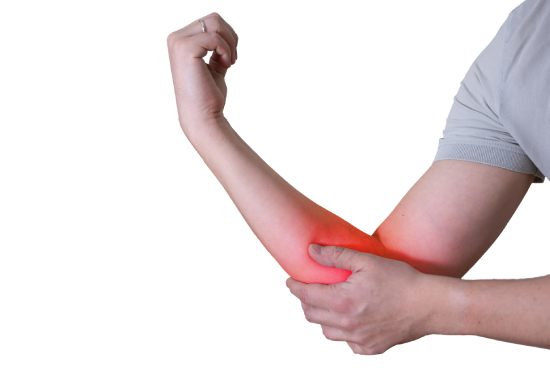Introduction to Elbow Physiotherapy
Comprehensive Physiotherapy Solutions for Elbow Conditions
Elbow pain can stem from various sources, such as sports injuries, overuse syndromes like tennis or golfer’s elbow, and traumatic injuries, including fractures. At Orthocure, our dedicated physiotherapists provide specialized treatments to alleviate pain, restore mobility, and strengthen the elbow joint. Utilizing a combination of manual therapy, tailored exercise programs, and cutting-edge modalities, we help patients overcome discomfort and return to their daily activities with improved elbow function.

Understanding Elbow Pain Challenges
Addressing the Complexities of Elbow Pain
Elbow pain can severely affect your ability to perform simple tasks and can arise from
Such as tennis elbow or golfer’s elbow, which require targeted therapeutic interventions.
Including fractures that necessitate comprehensive rehabilitation.
Like arthritis or bursitis, demanding ongoing management to reduce symptoms and maintain joint health.

Benefits of Physiotherapy for Elbow Pain
The Advantages of Physiotherapy in Managing Elbow Pain
Physiotherapy offers numerous benefits for elbow pain management
Pain Reduction
Through techniques such as manual therapy and modalities like ultrasound.
Increased Mobility
Via stretching and range of motion exercises.
Strength Enhancement
Through tailored strengthening exercises that support the elbow joint.
Prevention of Recurrence
By correcting biomechanical faults and improving ergonomic setups.
Types of Elbow Conditions Treated
Targeted Treatments for Various Elbow Issues

Our physiotherapy services cover a wide range of elbow conditions
Tennis and Golfer's Elbow
Focused on alleviating tendon irritation and enhancing tendon health.
Elbow Fractures
Rehabilitation programs designed to restore function after healing.
Elbow Stiffness and Tendonitis
Strategies to increase flexibility and decrease pain.
Post-surgical Recovery
Ensuring optimal recovery through progressive exercise regimes
The Orthocure Approach to Elbow Pain Physiotherapy
Our Effective Strategy for Elbow Rehabilitation
Comprehensive Assessment
To accurately diagnose the cause of elbow pain.
Personalized Treatment Plans
Tailored to meet individual recovery goals.
Multimodal Therapy Techniques
Combining physical therapy, exercise, and education.
Ongoing Support and Prevention
Guidance on maintaining elbow health and preventing future injuries.
Focus on Golfer's Elbow
Specialized Physiotherapy for Golfer's Elbow
Golfer’s elbow, or medial epicondylitis, is characterized by pain and inflammation on the inside of the elbow, often due to overuse of the forearm muscles. Effective management through physiotherapy is crucial for relief and recovery. Here’s how specialized treatments can help
Comprehensive Assessment
Initial evaluations pinpoint the specific tendon involvement and severity.
Customized Treatment Plans
Incorporating exercises to reduce tendon load and enhance tissue repair.
Targeted Manual Therapy
Techniques like massage and mobilizations to alleviate pain and improve mobility.
Ultrasound and Electrotherapy
To promote healing and reduce inflammation.
Strengthening Exercises
Gradual loading of the forearm muscles to build strength and prevent re-injury.
Stretching Routines
To maintain muscle flexibility and prevent stiffness.
Pain Management Strategies
Including taping and the use of braces if necessary.
Ergonomic and Technique Correction
To adjust how patients perform repetitive motions that could stress the elbow.
Education on Activity Modification
Teaching patients how to avoid movement exacerbating symptoms.
Ongoing Support and Advice
Providing patients with the tools to manage their condition independently and prevent future episodes.
FAQs on Elbow Physiotherapy
Physiotherapy treats tennis elbow primarily by reducing tendon irritation and increasing tendon strength through specific exercises and manual therapy techniques. Treatment may include soft tissue massage, stretching exercises to enhance flexibility, and strengthening exercises to build muscle endurance. Physiotherapists also use modalities such as ultrasound or shockwave therapy to promote healing. The goal is to alleviate pain and restore full function to the forearm and elbow, allowing patients to return to their normal activities without discomfort.
Recovering from the golfer’s elbow involves stretching and strengtheninggolfer’s the forearm muscles and tendons. Typical exercises include wrist flexor stretches, wrist curls with light weights, and grip-strengthening exercises using a tennis ball or similar objects. Physiotherapists may also recommend eccentric exercises to load the tendon gradually, which helps to promote tendon healing and resilience. These exercises are tailored to the individual’s pain level and functional needs to ensure adequate recovery.
Physiotherapy is crucial in healing elbow fractures by helping to restore mobility, strength, and function after the bone has healed. Initially, therapy focuses on gentle passive movements to maintain joint motion without stressing the healing fracture. As healing progresses, more active exercises are introduced to strengthen the muscles around the elbow and prevent stiffness. The final phase of physiotherapy involves functional exercises that mimic daily activities, ensuring that the elbow can perform its normal functions effectively.
Signs that you might need physiotherapy for elbow pain include persistent or recurring pain, decreased mobility, difficulty performing everyday tasks such as lifting objects or opening doors, and stiffness, especially in the morning or after periods of inactivity. If the pain interferes with your daily activities or you notice swelling and redness around the elbow, consulting a physiotherapist can help diagnose the issue and recommend an appropriate treatment plan.
Recovery from elbow surgery with physiotherapy can vary depending on the type of surgery performed and the individual’s overall health. Typically, it can take several weeks to several months. Physiotherapy starts with managing post-operative pain and swelling, gradually progressing to exercises that restore mobility and strength. Consistent participation in a rehabilitation program is essential for adequate recovery, and the physiotherapist will regularly assess progress and adjust the treatment plan as needed to ensure the best outcomes.
Physiotherapy for elbow bursitis typically involves techniques to reduce inflammation and pain, such as icing, compression, elevation, ultrasound, or electrical stimulation. Once the acute inflammation is managed, the therapy may include gentle mobility exercises to prevent stiffness and gradual strengthening exercises to support the elbow joint. Education on activity modification and ergonomic adjustments to daily routines also plays a crucial role in managing and preventing elbow bursitis.
While physiotherapy is highly effective in treating many types of elbow pain, treatment success can vary depending on the underlying cause. Conditions like tennis elbow, golfer’s elbow, and post-operative recovery typically respond well to physiotherapy. However, some degenerative conditions or severe injuries may require additional medical interventions alongside physiotherapy. A comprehensive assessment by a qualified physiotherapist can determine the best treatment approach for each specific case of elbow pain.
The frequency of physiotherapy sessions for elbow pain can vary based on the severity of the condition and the specific treatment goals the physiotherapist sets. Typically, sessions may start one to two times weekly for acute conditions and decrease in frequency as the patient improves. The treatment plan needs to beIt’s dynamic, adjusting the frequency of visits according to the patient’s progress and pain levels. Ongoing assessment is crucial to ensure the treatment remains effective and make any necessary adjustments.
Physio tape is commonly used in the treatment of tennis elbow to support the muscles of the forearm and reduce strain on the tendons. The tape helps lift the skin slightly, decreasing pain and facilitating lymphatic drainage, reducing inflammation. It also supports the area without restricting movement, allowing patients to continue their activities with less discomfort. Physio tape can be a valuable part of a comprehensive treatment plan, particularly for those who need to maintain activity levels during recovery.
Self-care is essential to recovery from elbow injuries and can significantly complement physiotherapy efforts. This includes regular application of ice to reduce swelling, maintaining a gentle range of motion to prevent stiffness, and avoiding activities that exacerbate the pain. Using ergonomic tools and adjusting the workspace to minimise strain on the elbow can also help. Additionally, following any home exercise programs the physiotherapist prescribes is crucial for adequate recovery.
Physiotherapy can prevent future elbow problems by strengthening the muscles around the elbow, improving flexibility, and enhancing joint mechanics. Educating patients on proper techniques for sports and other activities can also reduce the risk of injury. Regular physiotherapy exercises tailored to individual needs can maintain elbow health and prevent the recurrence of chronic conditions like tennis or golfer’s elbow.
Physiotherapy effectively treats elbow stiffness, often resulting from injury, surgery, or prolonged immobility. Treatment typically involves manual therapy techniques to mobilize the joints and soft tissues, combined with exercises that promote range of motion and flexibility. Heat therapy may also be used to relax and loosen tissues before exercises. With consistent treatment, physiotherapy can help restore elbow mobility and reduce discomfort associated with stiffness.
For complex elbow conditions, advanced physiotherapy techniques may include manual therapy, dry needling, and specialized joint mobilization and strengthening exercises. High-tech modalities like laser therapy or extracorporeal shockwave therapy might also be employed to promote tissue healing and pain relief. These advanced techniques are used based on the specific needs of the patient and the nature of the elbow condition to ensure optimal recovery.
You should seek physiotherapy for elbow pain when it affects your ability to perform everyday tasks, if the pain persists beyond a few days, or if you experience symptoms like swelling, reduced range of motion, or pain during rest. Early intervention by a physiotherapist can prevent the condition from worsening and lead to a quicker and more effective recovery.

